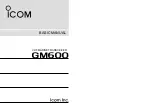
2 Theory of Operation
18
The Base Station consists of four functional components:
Receiver Board
The receiver is a double superheterodyne narrowband frequency modulation (FM) receiver, with two
mixers and two intermediate frequencies (IFs). Three radio frequency (RF) signals can be received
independently with three identical receiver channels.
The digital section of the main CPU is responsible
for frequency shift key (FSK) detection, analog-to-digital conversion of the low frequency (LF signal),
signal filtering, and radio frequency (RF) channel management.
The main CPU communicates with the
transducers.
While charge power is on, a serial communication link is established between the base station
and each docking slot.
Human Interface Board
The Human Interface (HIF) board provides the user interface, and the display, indicators, keys and the
slot charging contacts are all located on this board.
Power Supply
The power supply is a wide-range input swtching unit, with an output of +48V. It is located on the chassis
assembly.
Slot Control and Monitor Interface Board Hardware
The Monitor Interface (MIF) board provides the interface to the fetal monitor as well as the
communication interface to the transducer slots. Power conversion is performed by a DC-DC converter.
The digital (active) parts of the human interface also reside on this board.
The MIF board consists of the following functional blocks:
•
DC-DC Converter
- the 48V DC input for the DC-DC converter comes from the primary AC-DC
converter. Since the 48V DC voltage is sufficiently stabilized, two fixed pulse width step down
transformers are used to transform the high voltage down to the required 3V, 5V and 12V (post-
regulated for accuracy).
The +12V supply is mainly used for battery charging and you can access this voltage at the charge
contacts. The fuse on the MIF board are not replaceable, and if it blows, the board must be replaced. If
there is a short to ground, unlimited current will blow the fuse. To avoid this, a current limiter is used
to limit the output current.
•
Monitor interface
- three major blocks make up the monitor interface:
– PWM Toco digital-to-analog (D/A) converter
– Two PWM wave D/A converters for FHR low frequency (LF) 1, and FHR LF 2.
– Digital status ports
•
Transducer slot interface
- this block is responsible for transducer detection, safety features of the
charge power switch, serial communication between base station and transducers and synchronization
clock generation for the power supply.
To ensure that there is no charge power applied to the charge
contacts when there is no transducer docked in a slot, charge power in each slot is only applied after a
transducer has been detected.
•
Drivers for the HIF board interface
- this block contains the multiplexing and driving components for
the function buttons, the display backlight and the seven-segment LEDs.
Summary of Contents for Avalon CTS M2720A
Page 2: ...ii ...
Page 32: ...3 System Interfaces Compatible Fetal Monitors 26 ...
Page 66: ...6 Preventive Maintenance and Safety Battery Exchange 60 ...
Page 92: ...9 Upgrades 86 ...
Page 102: ...10 Specifications Essential Performance 96 ...
Page 104: ...A Removing and Replacing the Transducer Battery 98 Wipe off excess silicone grease ...
Page 108: ...C Avalon CTS Frequency Table 102 ...
















































